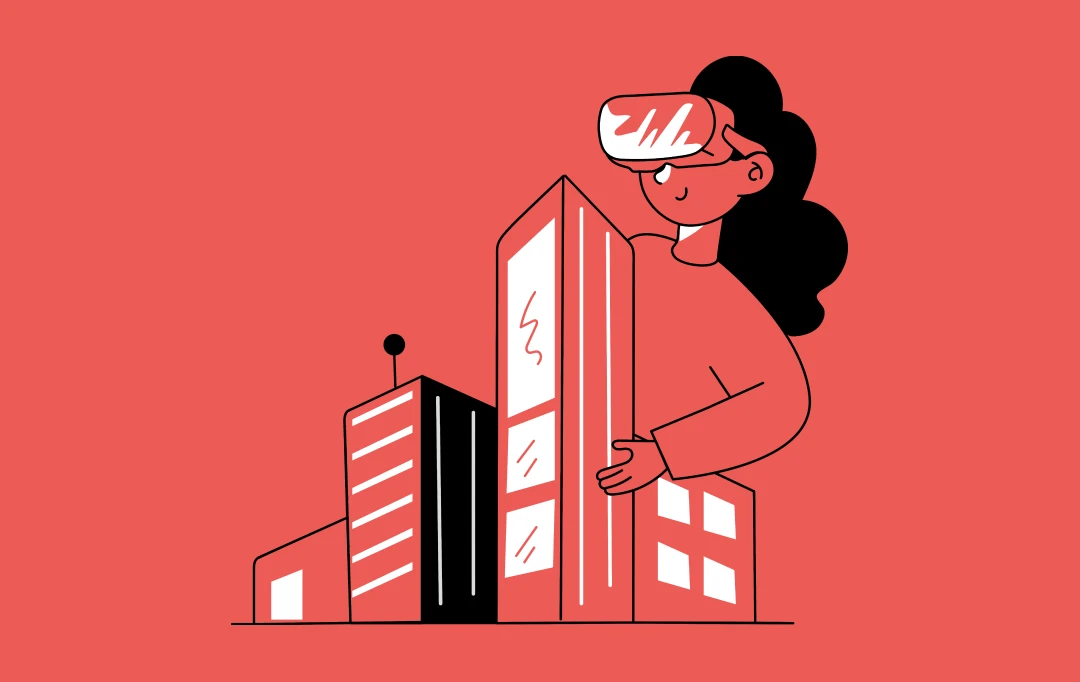- Augmented Reality Benefits for Businesses
- Elevated Customer Engagement
- Optimized Workflows
- Training Excellence
- Real-Time Data Insights
- Boosted Sales
- Visualized Product Experience
- Competitive Advantage
- Role of Augmented Reality in Business: Use Cases and Real-Life Examples
- 1. AR in Healthcare
- 2. AR in Retail and eCommerce
- 3. AR in Education and Training
- 4. AR in Travel & Tourism
- 5. AR in Entertainment
- 6. AR in Manufacturing and Supply Chain
- 7. AR in Social Media
- 8. AR in Real Estate
- 9. AR in Military
- How to Integrate Augmented Reality Into Your Business?
- Conduct Market Research
- Determine Use Cases
- Hire an AR App Development Expert
- Analyze Technology Requirements
- Create Integration Strategy
- Pick AR Platforms
- Create User-Friendly Experiences
- Test and Iterate
- Monitor and Analyze
- Craft Innovative AR Solutions With Appinventiv
- FAQs
It’s true that augmented reality (AR) is still entwined with games like Pokemon Go and fun activities like using Snapchat filters. However, the potential benefits of augmented reality for businesses are not just confined to this domain. As an advanced technology, AR has entered different business verticals and given a transformative look. It has proven to be a perfect weapon to taste success in the present competitive market.
A ripple effect is that the global AR market size, which was valued at $62.75 billion in 2023, is anticipated to reach $1,109.71 billion by 2030, growing at a CAGR of 50.7% during the forecast period 2023-2030.

However, if you are still clueless about augmented reality benefits for a business, this blog will be a good read for you. Here, we will discuss how AR is used in businesses of different industry verticals, the various benefits it offers. Let’s get started.
Augmented Reality Benefits for Businesses
When asked how augmented reality helps businesses, a myriad of benefits emerges. As enterprises leverage the transformative power of AR, they gain a competitive edge and successfully meet the evolving expectations of their audience. Let’s have a look at some of the top advantages of augmented reality in businesses.

Elevated Customer Engagement
By creating immersive and customized experiences, AR raises the bar for customer engagement. Customers can actively participate in brand storylines through interactive augmented reality applications, resulting in a stronger connection with your brand. Customers value and recall the distinctive and unforgettable encounters made possible by AR technology, which builds greater brand loyalty in addition to captivating audiences.
Optimized Workflows
AR goes beyond streamlining operational processes; it enhances efficiency, minimizes errors, and contributes to overall workflow optimization. By providing real-time data overlays and interactive guidance, AR aids employees in complex tasks, reducing the likelihood of errors and improving task completion times. This enhances productivity and creates a more seamless and error-free work environment, showcasing how AR is instrumental in modernizing the various aspects of business operational workflows.
Training Excellence
AR is a great tool for promoting training excellence because it offers employees realistic, hands-on scenarios that boost their ability to learn new skills and retain what they have learned. Since AR simulations are immersive, learners can apply their theoretical knowledge to real-world scenarios, strengthening learning objectives. This shows how augmented reality for business can be a transformative tool in achieving training excellence and equipping workers for real-world challenges.
[Also Read: VR training – How is Virtual Reality Helping Organizations Train Employees?]
Real-Time Data Insights
AR analytics provide organizations with useful real-time insights to make well-informed decisions. Businesses can quickly see user behaviors, preferences, and engagement patterns by utilizing AR-generated data, which enables them to make flexible changes to their marketing plans or product offerings. In addition to improving decision-making, this dynamic feedback loop allows companies to adjust quickly to shifting market conditions.
Boosted Sales
Augmented reality increases customer satisfaction, builds trust, and converts these positive experiences into tangible results, yielding higher conversion rates and augmented sales figures. By offering customers interactive and personalized product experiences, businesses harness the power of AR to create memorable brand interactions, encouraging a lasting impact that directly influences purchasing decisions, thereby boosting sales.
Visualized Product Experience
AR revolutionizes the user experience by offering visually immersive product trials. Before purchasing, shoppers can virtually try things in real-world settings with augmented reality applications. This dynamic and engaging interaction heightens the impression of product awareness while lowering the uncertainty of online purchases.

As users visualize items in their own environment, their confidence in their buying decisions is bolstered, fostering a more informed and satisfying shopping journey.
Competitive Advantage
Adopting augmented reality for business offers companies a stable competitive edge in the ever-changing market environment and puts them at the forefront of innovation. By integrating AR into their operations, companies are committed to delivering cutting-edge experiences and staying ahead of industry trends. This proactive strategy creates a forward-thinking company image and draws in tech-savvy clients, paving the way for long-term success in a constantly changing market.
Role of Augmented Reality in Business: Use Cases and Real-Life Examples
Augmented Reality revolutionizes businesses by integrating digital elements into the real world. AR elevates customer experiences with virtual try-ons in retail and streamlined assembling processes in manufacturing. By mimicking real-world situations, AR significantly improves employee training and helps the healthcare sector with medical training and surgery planning.
Furthermore, the education sector uses AR-enabled apps to create immersive learning environments, while real estate embraces AR for interactive property viewings. In marketing campaigns, companies use augmented reality to attract clients with interactive information.
As we further detail the use cases of AR for businesses below, you will witness how this advanced technology is actually enhancing consumer engagement and spurring innovation across industries.

1. AR in Healthcare
The role of AR in medical and healthcare app development is remarkable. The technology offers new opportunities and benefits to healthcare professionals, medical students, and others to get a better experience. Unlocking revolutionary changes, augmented reality in digital business is reshaping the industry through innovative solutions and immersive experiences.
Augmented Diagnosis
Patients often overlook some minor symptoms or fail to describe them to doctors. Because of this, healthcare professionals cannot diagnose and provide the right services to them. But, with the integration of AR into healthcare, both patients and doctors can better understand the symptoms and diagnose them effectively, resulting in better outcomes.
The globally recognized healthcare company Johnson & Johnson uses augmented reality for medical diagnoses. They utilize AR to improve diagnostic procedure accuracy, which helps medical practitioners recognize and comprehend patient symptoms more efficiently. This technology integration advances healthcare solutions in line with Johnson & Johnson’s mission to improve patient outcomes.
Augmented Surgery
Earlier, it was quite strenuous for surgeons and other healthcare professionals to make a complicated surgery successful with limited information gathered a few days before the surgery.
However, the advent of mixed and augmented reality in the surgery process has proven to be a game changer. Now, surgeons can access life-saving patient information in real-time, study the information precisely, and overlay the patient’s anatomy over the body to perform surgery accurately. They can visualize every body part and, this way, ensure that no other organ gets affected adversely during surgery, ensuring a higher success rate and a shorter recovery time.
Medtronic, a leading medical technology company, incorporates AR in surgical procedures. Their advances in AR minimize risks and enable precise treatments by giving surgeons access to real-time patient information during processes. Medtronic successfully integrates cutting-edge technology for medical improvements, as evidenced by its usage of augmented reality to ensure higher surgical success rates and quicker recovery periods.
Augmented Training and Practice
Another remarkable use case of AR in healthcare is that it makes training sessions more systematic. It makes medical students encounter real-life medical situations and asks them to act rather than going with random training in a dissection lab. This not only helps to test the knowledge and wits of the students but also how they handle stress and other emotions while treating patients.
Prominent pharmaceutical giant Pfizer uses augmented reality in medical education. Pfizer uses AR applications to improve medical professionals’ training by offering immersive experiences that mimic real-world medical scenarios. With this method, medical students can test their knowledge, gain practical experience, and handle the emotional aspects of patient care.
Also Read: How AR VR Apps Are Gamifying Exercise And Workout
2. AR in Retail and eCommerce
Virtual try-on experiences are one well-known use case of AR in retail and AR in eCommerce. With augmented reality applications, customers can virtually put on clothes, accessories, and even makeup to see how they will look. This function lessens the need for actual fitting rooms and aids in making informed purchasing selections.
AR can also be used to navigate within stores. With AR-enabled apps, customers can scan goods for more product information, find products inside a store, and receive tailored recommendations. Adopting augmented reality for business results in a more engaging and effective purchasing experience, which raises customer satisfaction and loyalty.
3. AR in Education and Training
In education, augmented reality enriches learning experiences by blending digital content with the physical world. Students can interact with 3D models, historical simulations, and immersive content through AR applications, similar to interactive textbooks or educational apps.
For instance, apps like Google Expeditions use AR to take students on virtual field trips to historical sites or natural phenomena. By improving understanding and memory, this interactive and visual method makes difficult concepts more approachable. In the classroom, AR encourages engagement and creates a dynamic, individualized learning environment that enthralls pupils and helps them comprehend academic subjects more deeply.
Another finest use case of AR in the education domain is the Human Anatomy Atlas. This mobile app shows more than 10,000 anatomical 3D models of the human body and delivers associated information in different languages, along with options like rotating and interacting with organs individually.

4. AR in Travel & Tourism
AR revolutionizes travel and tourism by offering immersive content and real-time information. Through screen overlays, travelers using AR-capable devices or mobile apps can obtain information about historical places, landmarks, and other points of interest. AR-guided directions make navigation simple and improve discovery.
For example, an AR app can offer historical insights when pointed at a monument, making the journey informative and engaging. Through the seamless mixing of the digital and physical worlds, this technology enhances travel experiences and helps visitors develop deeper connections with the places they visit.
The “Culture Trip” app is an excellent example of augmented reality in the travel and tourism industry. This platform combines AR elements to provide users with an immersive travel experience. The app allows visitors to access augmented reality guides, which will improve their knowledge of the area’s historical places, cultural attractions, and landmarks.
This demonstrates the immense power of augmented reality for businesses to completely change how people interact with and learn about their surroundings while also improving their travel experience and providing intelligent information in real-time.
5. AR in Entertainment
Entertainment is also one of the industries that is improving with the advent of Augmented Reality (AR). Technology has touched the industry’s subdomains in numerous ways, be it music, live events, or movies. For instance, Apple’s latest Apple Vision Pro is specifically designed to revolutionize user experiences with immersive augmented reality features.
AR in the Music Industry
AR-powered earbuds and other equipment add an augmented layer on top of the real audio to enhance users’ listening experience. And that, too, is personalized according to the background noise and other filters.
AR in Movies
In TV shows and movies, augmented reality enhances storytelling by seamlessly incorporating unrealistic elements like dinosaurs and enabling performers with physical disabilities to showcase effortless movements. It brings forth captivating visual effects and transforms the cinematic experience.

Besides, it enables users to see real-time subtitles on the TV show they are watching. Some of the movies that have embraced AR technology are Iron Man, Minority Report, Avatar, and Terminator.
AR in Media
Augmented reality also plays a pivotal role in the media industry. The technology enables media experts to enhance the effectiveness of multimedia, games, videos, and presentations to build a better impression. It encourages them to share their content highly interactively and enjoy better outcomes.
6. AR in Manufacturing and Supply Chain
The manufacturing industry’s remarkable growth has been driven mostly by integrating AR into mobile apps. For example, it drastically cuts down on the amount of time needed to maintain industrial operations. Finding certain items or equipment frequently takes up significant time in production and supply chain management. AR overcomes this difficulty by adding virtual labels, delivering 3D visuals, and providing navigational information by improving efficiency and streamlining procedures.

Furthermore, by enabling real-time package tracking from warehouse to doorstep, AR-powered mobile parcel delivery applications improve client experiences. These apps also provide useful product details like weight, size, and cost. This all-encompassing strategy raises customer satisfaction, which prompts a happier and more enthusiastic response from the clientele.
Volkswagen, a major player in the automobile sector, has integrated augmented reality into its manufacturing procedures. The organization employs AR apps to guide assembly line personnel on tasks like quality control inspections and difficult engine installations. Workers receive real-time instructions and visuals by superimposing digital information onto their physical surroundings, guaranteeing correctness and efficiency in their tasks.
7. AR in Social Media
Lastly, AR also redefines how people engage with social media. AR allows users to enhance their updates with catchy filters and view posts on the device screen, as seen in apps like the TweetReality app. On the other hand, it offers brands an opportunity to deliver an immersive experience to their target user base in the form of AR stories, 360-degree videos, AR-focused ads, and AR games.
Various social networking platforms like Snapchat, Facebook, and TikTok empower users to add AR features to their content and share with their app fellows. In fact, Snapchat launched a Lens Studio app back in 2018 to let users create their own AR filters.
8. AR in Real Estate
AR is reshaping the real estate industry, introducing an innovative approach to property viewing. Prospective buyers can experience virtual property overlays using AR apps on smartphones or AR glasses, highlighting minute information like room layouts, furniture arrangement, and possible upgrades. With the help of this immersive technology, customers can remotely explore properties and see them in an interactive, personalized way.
Leading platforms like Zillow use AR to display simulated furniture in empty rooms, enabling potential buyers to see a space’s full potential. This innovative application of AR improves decision-making and expedites the property discovery process, representing a major improvement in the consumer experience within the real estate sector.
You may like reading: Benefits, Use Cases, and Examples of AI in Real Estate
9. AR in Military
Another example of augmented reality for businesses is in the military sector. In fact, this industry is one of the foremost industries being disrupted by AR technology. When looking ahead to the use of AR in the military field, the technology helps soldiers prepare for battles. It aids in the disposal of bombs and other explosive elements and enhances their skills at using different weapons, without risking their lives. It adds labels to the real-world scenario and provides better navigation services to them – even in the dark. In addition, the technology also makes it possible to reap the perks of remote maintenance.

One of the finest examples of augmented reality in the military is the partnership between Microsoft’s HoloLens and the United States Army. The army uses HoloLens AR headsets to simulate combat scenarios and give soldiers realistic training scenarios where they can rehearse movements. This use of augmented reality highlights the revolutionary potential of AR in military operations by reducing dangers associated with live exercises while simultaneously improving training efficacy.
The use of augmented reality in the business world has left a remarkable impression on every sector, making it difficult for businesses with traditional processes to survive in the market. Thus, entrepreneurs must invest in enterprise augmented reality app development to propel their businesses forward in this dynamic landscape.
But is it that easy?
Since the technology is still evolving, you are likely baffled about when and how to embrace augmented reality business opportunities. So, considering the same, let’s look into how to prepare your augmented reality business plan and enjoy ample benefits.
[Also Read: 10 Use Cases Of How AR Is Changing The Way Consumers Interact With Banking And Financial Services]
How to Integrate Augmented Reality Into Your Business?
Businesses using augmented reality follow a proper roadmap, ensuring a systematic and effective integration. This strategic approach ensures that augmented reality solutions smoothly connect with company objectives and contribute to long-term success. It includes thorough planning, precise implementation techniques, and continuous evaluation.

Conduct Market Research
Rather than going with the hype, it is required that you dive deeper into your business market and understand the potential of technology. You must invest your effort into the augmented reality market and competitive analysis to see what AR can be used for, its future, and how the technology has helped them build a different image in the marketplace.
Determine Use Cases
Analyze the possible use cases of augmented reality in the industry. Determine places where augmented reality might provide value and address particular problems, from customer interactions to business operations.
Hire an AR App Development Expert
Once the problem and the outcomes possible with the inclusion of AR in business are evaluated, the next thing to do is to select the right AR VR development company. A company like Appinventiv, which has years of experience in creating augmented reality apps for business, will help you get acquainted with how the technology can mitigate your current challenges.
Analyze Technology Requirements
Evaluate the technology needed for AR integration, considering hardware, software, and potential partnerships. Ensure compatibility with existing systems and infrastructure.
Create Integration Strategy
Write a thorough plan explaining how augmented reality will support your company’s objectives. Consider factors like budget, schedule, and scalability to guarantee a successful implementation.
Pick AR Platforms
Decide which AR platforms or technologies best fit your needs as a business. Select platforms that support your goals, whether using pre-existing apps or creating bespoke ones.
Create User-Friendly Experiences
In augmented reality applications, the user experience should be prioritized. Provide user-friendly interfaces and captivating content to guarantee a seamless user journey.
Test and Iterate
Put augmented reality apps through extensive testing in real-world settings. To improve performance and fix any problems, get input and make iterations to the functionality and design.
Monitor and Analyze
Tracking systems should be implemented to monitor AR usage and gather information. Examine performance indicators concerning established goals and adapt based on facts when needed.
Craft Innovative AR Solutions With Appinventiv
Appinventiv is a trustworthy partner to help your business enter the augmented reality space. Our proficiency in developing AR applications guarantees that your business stands out and captivates your audience, resulting in more sales. Embrace the innovation and enter the “digitally augmented” business world without hesitation with our efficient AR app development services.
Get in touch with our experts today. Together, we can uncover countless opportunities and improve your company’s operations with augmented reality’s game-changing advantages, opening the door to success and innovation in the future.
FAQs
Q. How to build an augmented reality business?
A. Here are the basic steps to build an augmented reality business:
- Begin by identifying precise goals and analyzing relevant use cases of AR in the business.
- Determine the technological needs
- Create a thorough plan that complies with the company’s objectives
- Choose appropriate augmented reality platforms and create intuitive experiences
- Conduct testing and interaction process
- Invest in employee training and foster adoption
- Monitor and analyze AR usage with data-driven adjustments
- Gradually scale implementation based on feedback
Q. How is augmented reality used in businesses?
A. The use of augmented reality in business showcases its versatile applications, revolutionizing business operations across sectors. Whether enhancing brand awareness, presenting compelling product demonstrations, elevating customer experiences, or streamlining operational workflows, AR is a versatile tool for addressing a range of business goals.
This technology is not limited to a single use; rather, it is a flexible and dynamic resource that promotes efficiency and innovation across various industries. The adoption of augmented reality for business demonstrates a calculated strategy for making the most of augmented reality’s potential to raise brand awareness, engage consumers, and streamline internal operations. It ultimately supports the expansion and prosperity of contemporary companies.
Q. What are the benefits of AR in business?
A. There are myriad augmented reality advantages for businesses. Here are some of them:
- Enhanced Customer Engagement
- Streamlined Workflows
- Innovative Marketing Solutions
- Immersive Training Experiences
- Efficient Maintenance Support
- Interactive Learning Platforms
- Improved Product Demonstrations
- Increased Brand Awareness
Q. What is the future of augmented reality for enterprises?
A. The future of augmented reality for enterprises holds the promise of transformative advancements. Augmented reality is poised to further revolutionize training by integrating even more immersive simulations and streamlining workflows with increasingly sophisticated real-time overlays.
As enterprises embrace augmented reality, the technology is expected to play an increasingly integral role in elevating customer engagement, boosting brand awareness, and facilitating collaborative decision-making.
Q. What is the cost of implementing augmented reality in business?
A. The cost of implementing AR in business can range between $30,000 and $300,000 or more depending on the AR application’s complexity, the deployment scale, the specific features, and other considerable factors. Connect with the top AR development company to get a more precise estimate of cost and timeline.


- In just 2 mins you will get a response
- Your idea is 100% protected by our Non Disclosure Agreement.

10 Use Cases and Examples of How Extended Reality (XR) is Driving Innovation Across Industries
Imagine a factory where engineers diagnose machinery issues using 3D holograms or a hospital where surgeons rehearse complex procedures in a fully immersive virtual space before operating on a real patient. These scenarios are not distant possibilities - they are happening today and are powered by Extended Reality - XR use cases. As a convergence…

13 Use Cases and Examples of How Adaptive AI is Transforming Industries
Slashing downtime, boosting margins, automating workflow, and stealing your market share. You must be thinking that these buzzwords are Silicon Valley’s hype. No, these are the silent revolutions hitting Main Street industries. From manufacturing deploying demand forecasting to controlling production lines, healthcare tailoring predictive care and driving better outcomes. The success mantra—these industries are quietly…

AR/VR in Construction - 10 Use Cases of How Augmented and Virtual Reality is Shaping the Industry
The use of extended reality technologies is one of the growing trends in the expanding domain of construction technology. As the sector gradually adopts more sophisticated practices, virtual and augmented reality in construction have emerged as revolutionary solutions. With compelling advantages like planning, marketing, and training, AR/VR technologies are transforming the face of construction. Prescient…

















